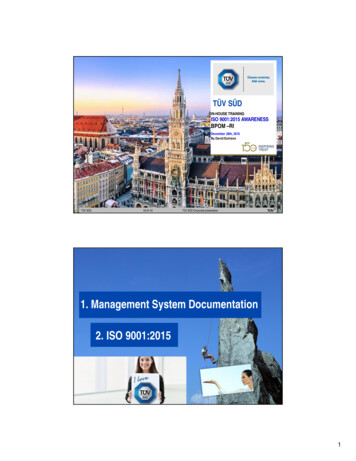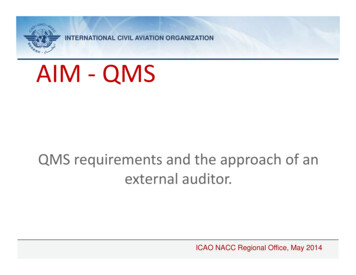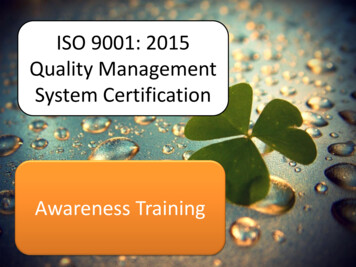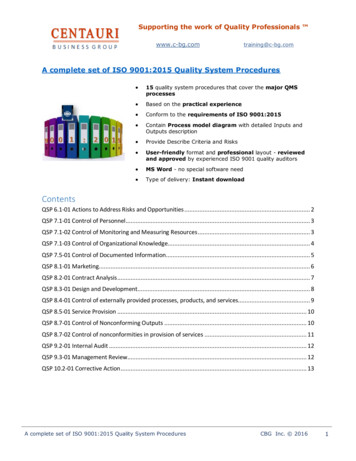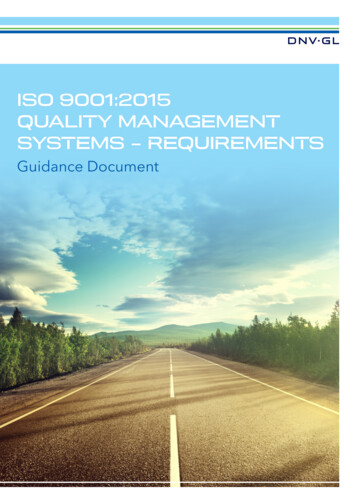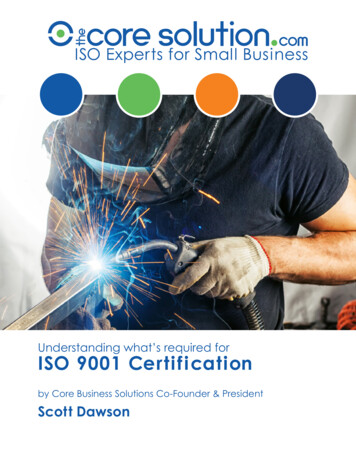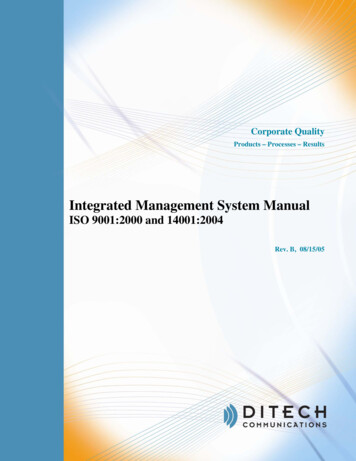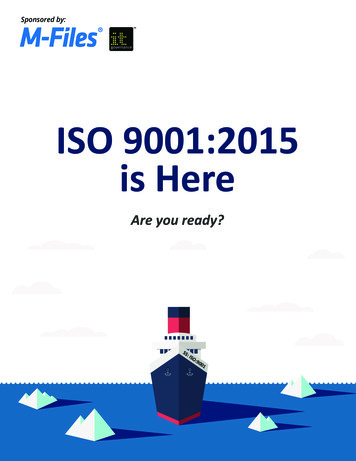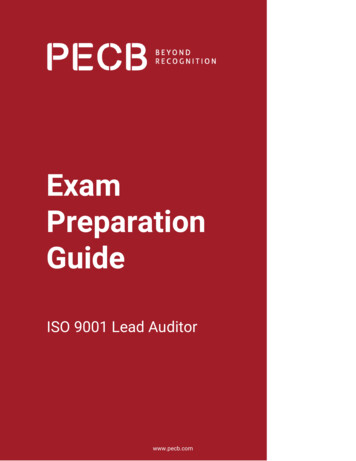
Transcription
Quality Management System ManualISO 9001:2015Quality Management SystemManual
Quality Management System ManualIntroductionCompany has made the “Strategic Business Decision” to develop and implement aneffective Quality Management Systems (QMS) across all areas of the Company.The implementation of the QMS is intended to improve and sustain the overallperformance of our business, products and services. Examples of the benefitsinclude: the ability to consistently provide products and services that meet customer andapplicableStatutory and Regulatory requirements; the ability to plan our processes and their interactions by employing the PlanDo-Check-Act(PDCA) cycle and risk-based thinking in our daily operations; the facilitating of opportunities to enhance customer satisfaction; addressing risks and opportunities associated with its context and objectives.The QMS Manual is considered the normative basis of reference to the InternationalStandard and shall be used internally to provide an overview of ISO 9001:2015 (E)requirements and how theyapply at Company. The QMS Manual is used externally to introduce the elements ofour QMSto our customers and other external organizations to the extent necessary.Quality Management PrinciplesCompany has adopted and realizes the benefits of Quality Management Principlesinto our daily activities. The intent of the Quality Management Principles is toprovide a foundation to continually improve upon the Company’s performance.Subsequent sections of the QMS Manual will provide our commitments of thefollowing QMP elements: customer focus; leadership; communications and the engagement of our people; process approach; improvement;
Quality Management System Manual risk & opportunity as well as evidence-based decision making; relationship management.Process ApproachThe “Process Approach” should be adopted into our daily operations including thePDCA Cycle. We have considered the utilization of Risk-Based ThinkingPhilosophy when developing, implementing, and improving the effectiveness of ourQuality Management System. This approach will enable to enhance the overallperformance of the Company by effectively controlling the interrelationships andthe interdependencies among the QMS processes. The implementation of the“Process Approach” in our QMS enables; the understanding and consistency with achieving customer specificrequirements; the consideration of our processes in terms of added value; the achievement of effective process performance; improvement of our processes based on the evaluation of data and information.
Quality Management System ManualRisked-Based ThinkingThe implementation of risk-based thinking is an essential tool for achievingand maintaining an effective QMS. Its effectively plans and implementsvarious actions to address risks and opportunities to maximize the outcomesincluding, but not limited to achieving improved results and preventingnegative effects of our products, services and QMS.1 ScopeThe scope and intent of our QMS is to define and communicate ourcommitment to continually enhance customer satisfaction through:o Effective process improvements to all systems of the business;o To assure conformity to our customer’s and applicable statutory andregulatory requirements;Provide policies, procedures developed and implemented with the primaryfocus to assure the continual compliance of the requirements of theInternational Standard ISO 9001:2015(E)2 Normative ReferencesThe following documents in part or whole, are normatively referenced or usedin the preparation of this document and are indispensable for its application. Fordated references, only the edition cited shall apply. International Standard ISO 9001:2015(E) Quality Management SystemsRequirements, Quality Management Fundamentals and Vocabulary. American National Standard ANSI/ISO/ ASQ 9004-2009: A QualityManagement Approach- Managing for the Sustained Success of anOrganization. International Standard ISO 10002: Quality Management - CustomerSatisfaction – Guidelines for Complaint Handling in the Organization. Annex A: Clarification of New Structure, Terminology and Concepts. Annex B: Other International Standards on Quality Management andQuality ManagementSystems Developed by ISO/TC 176.3 Terms and DefinitionsFor the purpose of this document, the terms and definitions provided in ISO9000 2015 apply.
Quality Management System Manual4 Context of the OrganizationUnderstanding the Organization and its ContextCompany management should determined relevant external and internal issuesand items that may become relevant to the company's purpose and strategicdirection, and may affect our ability to achieve the intended results of the QMS.Understanding Requirements and Expectations of Interested PartiesThe effect or potential effect on our organizations ability to consistentlyprovide products and services that meet our customer and applicable statutoryand regulatory requirements, company should determined the following: the interested parties relevant to the QMS; the requirements of the identified interested parties relevant to the QMS;Company should committed to continually monitoring, reviewing andanalyzing information and relevant requirements of the interested parties toassure their requirements are effectively managed in the QMS.Determining the Scope of the Quality Management SystemCompany should determined the boundaries and the applicability of the QMSand how it relates to our Business Core Competency.Company should committed to applying all applicable requirements of theInternational Standard to the intent and Scope of our QMSThe Scope of our QMS shall always be available to internal and externalparties and maintained as documented information. The QMS was determined,designed and implemented to cover and support the following Scope:o Full Service CNC Machiningo Sub-Assembly of Components
Quality Management System ManualExclusion of the QMS (8.3) - Design and Development of Products andServices.Justification Company does not perform design activities therefore thefulfillment to the requirements of this Clause are not applicable to our QMS.Company verifies the output of our customers design through measurements,fit checks, and visual inspections of the machined and/or assembled product(s)to the customer drawings, specifications and quality plans.Quality Management System and its ProcessesCompany has established, documented and implemented our QualityManagement System (QMS) in accordance with the requirements of ISO9001:2015 (E). The QMS is maintained and continually improved through theuse of the quality policy, quality objectives, audit results, analysis of data,corrective and preventive action and management review. Company utilizesQuality System Procedures (QSP) to provide our employees and externalproviders (Suppliers), with detailed “How To” instructions and requirements.The documents support the achievement of quality compliance for each of theprocess steps. We retain Quality System Forms (QSF) which providedocumented information substantiating the process inputs and outputs havebeen accomplished as planned.5 LeadershipLeadership and CommitmentManagement is actively involved in implementing the QMS, and isaccountable for its overall effectiveness. Management has initiated and fullysupports the vision and strategic direction for the continued sustainability andenhancement of the QMS. The President and Business Manager have initiatedand fully support the Quality Policy and Quality Objectives. Management iscommitted to the development and implementation of the QMS and to supportcontinually improving its effectiveness. Management provides direction to theintegration of the QMS requirements into each business process of theorganization and is committed to promoting the use of the Process Approachand Risk-Based Thinking, as well as the engagement and motivation of ouremployees throughout our QMS.
Quality Management System ManualCustomer FocusCompany ensures customer requirements and expectations are clearly defined,understood and achieved at all levels of the organization. We are committed toachieving 100% customer satisfaction and will accomplish this byunderstanding and mitigating risks and opportunities that may affect theconformity of products and services and to assure Statutory and Regulatoryrequirements are identified and achieved according to the applicable Clauses ofthe QMS Manual, Quality System Procedures and Quality System Forms.Establishing and Communicating the Quality PolicyThe President and Business Manager have initiated and communicated theQuality Policy throughout the organization and made it available to relevantinterested parties as appropriate. The Quality Policy is appropriate to thepurpose and context of the company and supports its strategic direction. Itprovides the framework for setting quality objectives, satisfying applicablerequirements and supports the Company’s commitment for continualimprovement of the QMS.Quality PolicyCompany Quality Policy and Mission Statement “to be a world-class supplierof precision- machined parts, sub-assemblies and to achieve success through ashared commitment to meet or exceed our customer’s expectations throughteamwork, continuous improvement, and innovation. To achieve our mission,it is essential that we focus on quality in everything we do throughout ourorganization”.Organizational Roles, Responsibilities and AuthoritiesThe Organization Chart has been established to provide the interrelation andreporting structure of personnel within the organization. The BusinessManager has been appointed by the President to oversee and manage theoverall effectiveness and compliance of the QMS. The Business Manager hasthe following responsibility and authority to: ensure QMS conforms to the requirements of international standard ISO9001:2015(E); ensure interaction of processes and their ability to achieve planned results;
Quality Management System Manual report to top management on the results achieved by the QMS, possibilitiesfor improvements and the needs of changes or innovations; maintain QMS integrity when planning and implementing changes; promote awareness of customer focus throughout the organization; act as a liaison with external parties such as customers or auditors onmatters relating to the QMS; resolve all matters pertaining to quality issues.The Business Manager has the organizational freedom and unrestricted accessto resolve matters pertaining to Quality Management System as well as to bethe Company liaison with external parties, including our customers andvendors on all matters relating to the QMS.6 PlanningActions to Address Risks and OpportunitiesWhen planning our QMS, Company has taken into consideration potentialissues and has determined the risks and opportunities that need to be addressedto: provide assurance that the QMS can achieve its intended result; enhance desirable effects; prevent, or reduce, undesired effects; achieve improvement;Company has planned actions to address the above risks and opportunities andhas initiated appropriate procedures to integrate and implement appropriateactions into our QMS including the evaluation of the effectiveness our QMSprocesses.Any actions taken to address risks and opportunities shall be proportionate tothe potential impact on the conformity of products and services.Quality Objectives and Planning to Achieve ThemQuality Objectives have been established at all corresponding levels andprocesses throughout the organization to implement the quality policy, meetand exceed requirements for product and processes, and to improve the QMSand its performance.
Quality Management System ManualQuality Objectives:Quality objectives are strategic, apply to the entire Company and shall: be consistent with the Quality Policy;be measurable and monitored;take into account applicable requirements;be communicated;be updated as appropriate;be relevant to conformity of products, services and enhance customersatisfaction.Quality Performance Objectives are measurable targets for improvingoperational performance to ensure process conformity and customersatisfaction. They apply to all departments and functions having directresponsibility for activities that require improvement. Performance objectivesand goals are established by management and through employee involvementand monitored within the framework of management reviews.Company retains documented information on the status of our qualityobjectives. If shortfalls are identified, management may revise objectives, issuecorrective action requests, or take other appropriate actions to address theissue.Planning of ChangesWhen changes to the QMS are deemed necessary, Company shall ensure thechange will comply with the requirements of ISO 9001:2015 (E) and shallconsider: the purpose of the changes and their potential consequences;the integrity of QMS;the availability of resources;the allocation or reallocation of responsibilities and authorities.Related DocumentsQSP-006-001 Risks & Opportunities QSP-006-002 Quality ManagementSystem Planning
Quality Management System Manual7 SupportCompany is fully committed to providing adequate resources required for theestablishment, implementation, maintenance and continual improvement of ourQMS. Our committed resources include: competent employees, state of theindustry equipment, well maintained work environment and financialresources. The process for determining and communicating resourcerequirements is an integral part of our management review process. Ourinfrastructure resource considerations include: management review meeting inputs and outputs; capabilities and constraints on existing internal and external resources; requirements and expectations provided by our external providers/vendorsPeopleCompany identifies personnel training needs, provides required training, andevaluates theeffectiveness of the training provided. Personnel assigned to perform specifictasks, operations and processes are qualified on the basis of appropriateeducation, experience or training. Employees are made aware of the relevanceand importance of their activities and how they contribute to the achievementof quality objectives. Records of personnel qualifications and training aremaintained.InfrastructureCompany has determined and provided resources necessary for theestablishment,implementation, maintenance and continual improvement of the QMS. Ourinfrastructure resource considerations include: buildings, workspace and associated utilities; equipment including (hardware and software); transportation resources; information and communication technology.
Quality Management System ManualAs new infrastructure requirements are determined to be necessary, they willbe documented in quality plans and other documents as required.Environment for the Operation of ProcessesManagement identifies and manages the human and physical factors of thework environmentconsidered to be important to control processes and to achieve conforming ofproducts and services. Evaluations include: assessment of product requirements to identify where human and/orphysical factors will affect product quality this is also conducted duringadvanced product quality planning, Assessment of current working environment conditions to determine if thework environment is suitable to achieve conforming product. Implementation of work environment improvements needed to achieveconforming product. Continual assessment of work environment to ensure that adequate humanand physical factors are maintained.Monitoring and Measuring ResourcesCompany has determined the necessary monitoring, measurement andresources to be initiatedacross our QMS. The structure of internal resources includes but is not limitedto: monitoring and measuring equipment; documented procedures and forms; competent and qualified personnelMeasurement TraceabilityDocumented procedures outline the processes that control monitoring andmeasurement equipment used to accept products during production and serviceoperations. The procedures also include controls prior to, and after delivery ofproducts to our customers. Appropriate documented information is maintainedand provides objective evidence of compliance and conformity.
Quality Management System ManualOrganizational KnowledgeCompany considers the specific knowledge necessary for each operation andconsiders this asan important resource to ensure our people and processes are consistent andwill achieve conformity of the product and services provided by the Company.Specific organizational knowledge is defined, maintained and available to theextent necessary within appropriate procedures.CompetenceCompany has determined to the extent necessary the below elements ofcompetence for people performing work that may affect the effectiveness ofthe QMS. ensure employees are competent on the basis of their education, trainingand experience; initiate job descriptions including specific competency provisions; measure job performance for each employee on an annual basis; provide job and career training programs to the extent necessary; take actions when necessary to assist employees that exhibit less thandesirable results.AwarenessCompany has determined to the extent necessary persons performing work are: aware of the Quality Policy; aware of relevant quality objectives; aware of their contribution to the QMS effectiveness, including improvedperformance; implications of non-compliance to our QMS requirements.CommunicationCompany management has determined internal and external communicationrelevant to QMS, including the subject of the communication, whencommunication occurs, participant and ways of effective communication.
Quality Management System ManualDocumented InformationCompany maintains a documented QMS as a means to ensure that productsand services conform to specified requirements. The QMS consists of thefollowing three levels of documented information:Level 1 Quality Manual: provides the scope of the QMS and the applicableISO 9001:2015 (E) Clauses contained and supported by our QMS.Level II Quality System Procedures (QSP): provides detailed requirements foreach of our processes with the intent to specify who does what, when, where,how the process or action/task is performed, and what documentation is used toverify that all required quality related activities had been executed as required.Level III: Quality System Forms (QSF): provides objective evidence thatrequired product or service quality and customer requirements were achieved,and that the company's quality management system has been implemented asstated. QSF refers to tags, labels, stickers, preprinted sheets, stamps, and othermeans to identify the status of materials, products, equipment, gauges, andother devices used in the company to achieve the specified requirements.Creating and UpdatingWhen creating and updating documented information Company ensures thefollowing: the identification and description (revision date, approval etc.); the format and media (electronic, paper hard copy etc.); the review and approval for suitability and adequacy.Control of Documented InformationDocumented information required to support the effectiveness of our QMS iscontrolled to ensure: it is available and suitable for use, where and when it is needed; it is adequately protected from loss of confidentiality, improper use, or lossof integrity. distribution, access, retrieval and use;
Quality Management System Manual storage and preservation, including preservation of legibility; control of changes; retention and disposition.Documented information of external origin determined to be necessary for theplanning and implementation of the QMS is identified as appropriate andcontrolled in accordance with Quality System Procedures and Forms.Related DocumentsQSP-07-001 Control of Documents &InformationQSP-07-002 CalibrationQSP-07-004Employee Training &CompetenceQSP-08-012 Contract ReviewQSP-09-002 Management ReviewQSP-09-003 Customer Satisfaction
Quality Management System Manual8 OperationOperational Planning and ControlCompany defines the expectation and implements controls for each of our QMSprocesses. The planning of controls is required to ensure consistent acceptabilityof products and services. Planning processes include the definition of qualityobjectives, development for required processes, establishment for appropriateverification programs and the requirement for records necessary to demonstratethe process and products conform to intended requirements. Operational planningand control is required prior to new and/or revised products or processes beingimplemented. During the planning phase, management will identify: requirements for the products and services; criteria for the processes and the acceptance of products and services; resources needed to achieve conformity to the product and servicerequirements; control of the processes in accordance with the criteria; documented information to the extent necessary to have confidence that theprocesses have been carried out as planned and to demonstrate the conformityof products and services to their requirements.The output of operational planning and control includes documented qualityplans, resource requirements, processes, equipment requirements, procedures,test data, and design outputs.Operational Planning and Control
Quality Management System ManualCustomer CommunicationCompany has implemented an effective system for communicating withcustomers the systemincludes but is not limited to: information relating to product and service information; inquiries, contracts and order handling, including amendments; customer feedback, including customer complaints; specific requirements for contingency actions, when relevant.Determination of Requirements Related to Products and ServicesCompany requires that all customer specific requirements for products andservices are clearly defined by the customer including but not limited to: applicable statutory and regulatory requirements; requirements considered necessary by Company; acceptance that Company can meet the products and services provided.Review of Requirements Related to Products and ServicesCompany ensures we have the ability to meet the requirements for products andservices to be offered to customers. Management conducts a contract/productreview prior to committing to supply products and services to a customer. Thereview process at a minimum includes: requirements specified by the customer, including the requirements fordelivery and post- delivery activities; requirements not stated by the customer, but necessary for the intended use,when known; requirements specified by the organization; statutory and regulatory requirements applicable to the products andservices; contract or order requirements differing from those previously expressed.Company ensures contracts, purchase orders or other requirements differingfrom those previously defined, are reviewed and approved prior toincorporating into our business systems. We retain applicable documented
Quality Management System Manualinformation of the initial review and on any new/revised customer orapplicable external party requirements for the products and services provided.Changes to Requirements for Products and ServicesCompany ensures that relevant documented information is amended, and thatrelevant persons are made aware of the changed requirements, when therequirements for products and services are changed.Control of Externally Provided Processes, Products and ServicesCompany maintains responsibility for the quality of all products purchasedfrom external providers, including customer designated sources. Proceduresensure products and services being provided by external sources will conformto our customers’ requirements. Examples of our controls include: a documented Approved Vendor List (AVL); the review of external provider’s performance.Type and Extent of Control of External ProvisionCompany ensures that externally provided processes, products and services donot adversely affect our ability to consistently deliver conforming products andservices to our customers. Vendors demonstrating inadequate performance willbe required to implement corrective actions. Poor performing vendors will bereplaced.Information for External ProvidersCompany uses purchase orders to define the product or services to bepurchased. Purchase Orders are created in the company E2System, bydesignated individuals within the Company. Purchasing documents arereviewed for adequacy and approved by purchasing personnel prior to release.Purchasing documents clearly describe the product or service to be provided.Production and Service ProvisionControl of Production and Service ProvisionCompany plans and implements production and service provision undercontrolled conditions and as required by job specific requirements. Examplesof the controls include: availability of information that define characteristics and results to beachieved;
Quality Management System Manual availability of competent and effectively trained personnel and adequateequipment; availability and use of suitable monitoring and measuring devices andresources; evidence that all manufacturing and inspection operations have beencompleted as planned;Manufacturing procedures, job travelers, inspection plans, and otherdocuments deemed necessary, define the acceptance for manufacturing andservice operations. The plans provide detailed instruction and guidance for allproduction and service phases including the methods and equipment to be usedand workmanship criteria. Records for each job number of product producedprovide uniquetraceability and identify the quantity manufactured and released for delivery.This record is maintained as required by customer contract requirements.Identification and TraceabilityCompany identifies parts and products by suitable means throughoutproduction. Markingmethods will be described in the applicable operations procedures for affecteddepartments. Where traceability is a requirement, the Company controls andrecords the unique identification of the outputs. According to the level oftraceability required by contract, regulatory or other established requirement,our procedures provides for: identification to be maintained throughout the processes including deliveryand post-delivery; identification of sub-components and those of the next higher assembly;Property Belonging to Customers or External ProvidersCompany exercises care with property belonging to customers or externalproviders while it isunder our control or being used. Procedures are established for the control,storage, maintenance and accounting of Customer/Government furnishedmaterials, tooling and equipment including data used for design, productionand/or inspection provided to the Company for the performance of work undera specific contract or contracts.
Quality Management System ManualPreservationCompany preserves the conformity of parts and products during internalprocessing anddelivery to the intended destination including outside services. Proceduresinclude instructions for identification, handling, packaging, storage andprotection. Preservation of outputs also includes, where applicable: cleaning; prevention, detection and removal of foreign objects; special handling for sensitive outputs; marking and labeling including safety warnings; special handling for hazardous materials.The shipping department ensures that documents required by the contract/orderto accompany the product are present at delivery and are protected against lossand deterioration.Post-Delivery ActivitiesCompany maintains documented information of all products delivered to ourcustomers. Theextent of post-delivery activities includes consideration our customer’srequirements and received feedback.Control of ChangesCompany shall review and control changes for production or serviceoperations to the extentnecessary to ensure continuing conformity of customer or internalrequirements. Changes for production may be initiated as a result of: modernization based on the context of the organization analysis results; needs of interested parties, or customer feedback ; manufacturing department when vulnerability is detected and (or)opportunities for improvement are identified.Management reviews and monitors changes that affect production or outsideservices and ensures change documentation and information is distributed andcontrolled. Records of results of the review of changes, the personsauthorizing the change, and any necessary actions arising from the review aremaintained in accordance with applicable procedures.
Quality Management System ManualRelease of Products and ServicesCompany monitors and measures the characteristics of the product in receivinginspection, in- process inspection, and final inspection to verify thatrequirements have been met. Documented procedures have been establishedfor product inspection. Documented Records and information of inspectioninclude evidence of conformity with the acceptance criteria and traceability tothe person authorizing the release. Records of inspection are maintained.Control of Nonconforming Process Outputs, Products and ServicesCompany ensures that products or services that do not conform to establishedrequirements are identified and controlled to prevent their unintended use ordelivery. Records of nonconformities are maintained as required and include: description of nonconformity; description of actions taken; description of conces
International Standard ISO 9001:2015(E) 2 Normative References The following documents in part or whole, are normatively referenced or used in the preparation of this document and are indispensable for its application. For dated references, only the edition cited shall apply. !International Standard ISO 9001


